基于基因调控网络(Hopfield network)构建沃丁顿表观遗传景观
基因调控网络的概念在之前已经简要介绍过:https://www.cnblogs.com/pear-linzhu/p/12313951.html
沃丁顿表观遗传景观(The Waddington's epigenetic landscape) 是描述基因调控下细胞分化的动态性的一个经典的隐喻,是由沃丁顿在1957年提出的。他将细胞分化比喻作从高处沿山坡滚落下的小球,直到一个稳定的盆地 (basin),该盆地也就代表一定的分化状态。小球最开始能量较高,处于不稳定状态,对应干细胞等未分化的细胞状态,小球最终滚落于低能量的盆地,较稳定,对应分化后的细胞。小球(干细胞)沿着不同的路径最终可以进入不同的盆地(分化为不同的细胞)。图示如下:
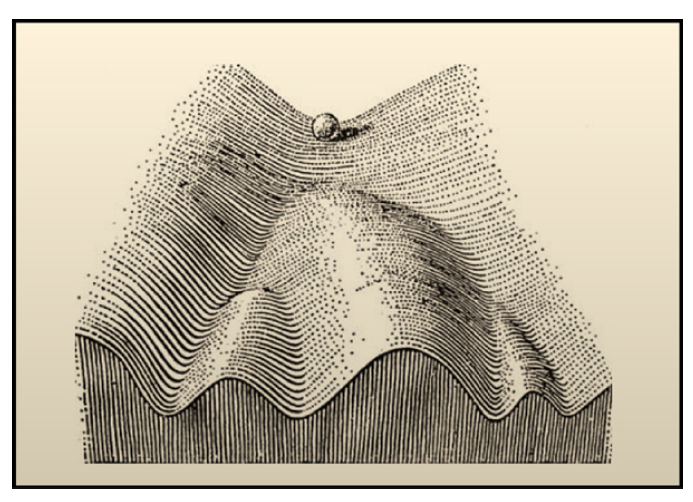
接着介绍两篇数据驱动的建模 (建立landscape模型) 文章,两篇文章都是基于Artificial neural network中的Hopfield Network(HN)的,Artificial neural network也是构建基因调控网络的方法之一。第一篇基于离散的HN,第二篇基于连续的HN。
<Characterizing cancer subtypes as attractors of Hopfield networks [1]>
The GRN model of this paper is based on the artificial neural network, discretized Hopfield Network. In this paper, they use the static gene expression profiles to construct the discretized Hopfield Network to mapping cancer subtypes onto the attractors of the landscape.
Here’s a basic model of Hopfield Network:

Each node represents a gene, and its output as the gene expression value, that is, state. The state of a node will be updated by all of its neighbors’ states within an iteration. The formula as follows:
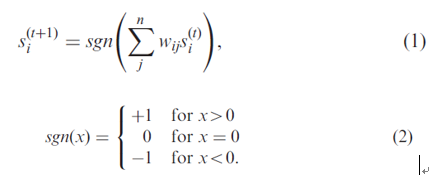
si(t) is the state of node i at time t, wij is the weight of the edge between node i and j.
The W will be learned by Hebbian learning.

P is the pattern matrix, p=sgn(D), D is the expression matrix.
After several iterations, we can get a stable state. And the stable state can be visualized by the expression matrix.

We can observe from the above figure that it gets into a stable state gradually, and the up and down parts corresponding to the subtype of cancer respectively, B-ALL and T-ALL. There is an error marked by a triangle in the upper stable state, but it won't influence the whole stable state.
Notably, they consider the sparse character of GRN, but the W learned by the Hebbian learning algorithm will be dense. They adopt a pruning method. At the premise of the accuracy of the classification of cells decrease within 20%, they delete the smaller weight edge.
Then, to visualize the landscape, they use the PCA to reduce dimension. As regular, they divide mesh on the 2D plane and do inverse PCA to map mesh points into the high dimensional space. Finally, based on the mesh points and true data points, we use the energy function E to plot them in the 3-dimensional space.

E is a Lyapunov function.
Finally, by interpolating values, we can get the landscape with the surface.
<HopLand: single-cell pseudotime recovery using continuous Hopfield network-based modeling of Waddington’s epigenetic landscape [2]>
The GRN model of this paper is based on the artificial neural network, Continuous Hopfield Network (CHN). In this paper, Hopland constructs landscape using continuous Hopfield Landscape (CHN) based on the gene expression data. And the pseudotime is estimated by the geodesic distance on the landscape. In this paper, they think the biological system cannot be characterized by the two-state discretized Hopfield Network, but a continuous relationship between input and output. As same as the last paper, each neuron represents a gene in the neural network.
As far as the model of CHN, vi represents the output of neuron, namely, gene expression value, N is the gene number, the input of neuron consists of noise and other neurons' output. The change rate of neuron i can be modeled as:
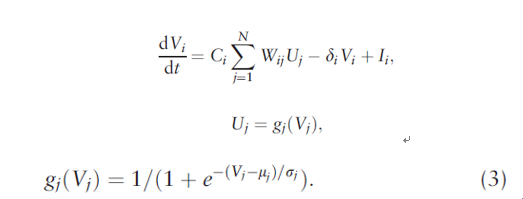
Ci is an amplifier, Wij is the weight matrix, gj() is the activated function, a sigmoid function as a gj() here, it's monotone increasing to assure the stableness of system. δi is the degeneration rate of gene i, Ii is the outer input.
To inferred these parameters, they construct two objective functions to generate simulated data at the premise that a realistic model can generate simulated data consistent with the true data.
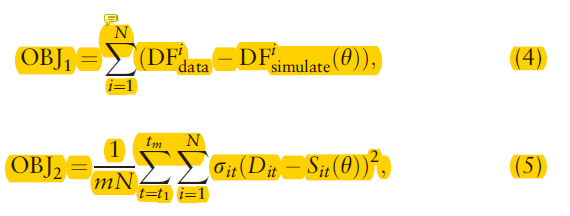
DF as the density function and the OBJ1 to assure the distribution of true data and simulated data is consistent. And I can't understand OBJ2 well.
A gradient descent learning algorithm is been used to update the parameters in the CHN.
The energy function here is also a Lyapunov function:

The steps of visualization of the landscape are consistent with the paper [1]. The only different point is the dimensionality reduction method, it uses nonlinear GP-LVM to replace the linear PCA. They think the nonlinear method is more suitable for biological information extraction.
To estimate the pseudotime, they use the fast marching algorithm to extract the geodesic distance and then construct the MST. The pseudotime of the ith cell is estimated as the distance between the corresponding tree node with the root node.
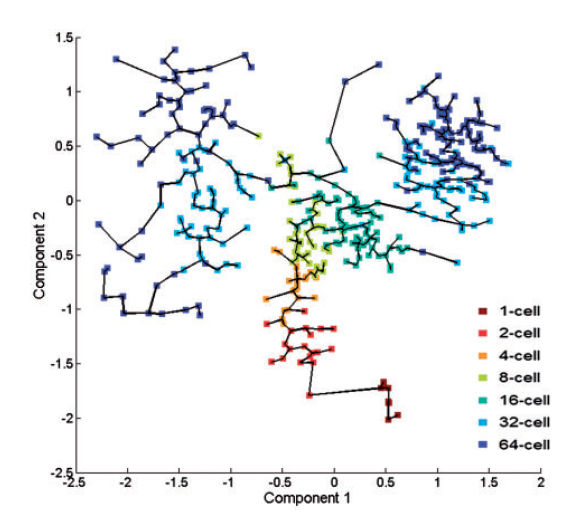
Ref:
[1]. Maetschke S R, Ragan M A. Characterizing cancer subtypes as attractors of Hopfield networks[J]. Bioinformatics, 2014, 30(9): 1273-1279.
[2]. Guo J, Zheng J. HopLand: single-cell pseudotime recovery using continuous Hopfield network-based modeling of Waddington’s epigenetic landscape[J]. Bioinformatics, 2017, 33(14).
基于基因调控网络(Hopfield network)构建沃丁顿表观遗传景观的更多相关文章
- 基因调控网络 (Gene Regulatory Network) 01
本文为入门级的基因调控网络文章,主要介绍一些基本概念及常见的GRN模型. 概念:基因调控网络 (Gene Regulatory Network, GRN),简称调控网络,指细胞内或一个基因组内基因和基 ...
- 项目文章|DNA(羟)甲基化研究揭示铁离子依赖表观调控促进狼疮致病性T细胞分化|易基因
易基因(羟)甲基化DNA免疫共沉淀测序(h)MeDIP-seq研究成果见刊<Journal of Clinical Investigation> 2022年5月2日,中南大学湘雅二医院赵明 ...
- 综述 - 染色质可及性与调控表观基因组 | Chromatin accessibility and the regulatory epigenome
RNA-seq这个工具该什么时候用?ATAC-seq该什么时候用?有相当一部分项目设计不行,导致花大钱测了一些没有意义的数据. 还是在中心法则这个框架下来解释,这是生物信息的核心.打开华大科技服务官网 ...
- Hopfield Network 霍普菲尔德网络入门
简介 Hopfield Network (霍普菲尔德网络),是 Hopfield 在1982年提出的一种基于能量的模型,发表的文章是 Neural networks and physical syst ...
- 【RS】Collaborative Memory Network for Recommendation Systems - 基于协同记忆网络的推荐系统
[论文标题]Collaborative Memory Network for Recommendation Systems (SIGIR'18) [论文作者]—Travis Ebesu (San ...
- (数据科学学习手札47)基于Python的网络数据采集实战(2)
一.简介 马上大四了,最近在暑期实习,在数据挖掘的主业之外,也帮助同事做了很多网络数据采集的内容,接下来的数篇文章就将一一罗列出来,来续写几个月前开的这个网络数据采集实战的坑. 二.马蜂窝评论数据采集 ...
- Java - 网络编程(NetWork)
Java - 网络编程(NetWork) 一.java.net包下的 InetAddress 类的使用: > 一个 InetAddress 代表着一个IP地址 > 主要 ...
- 基于Spring Cloud和Netflix OSS构建微服务,Part 2
在上一篇文章中,我们已使用Spring Cloud和Netflix OSS中的核心组件,如Eureka.Ribbon和Zuul,部分实现了操作模型(operations model),允许单独部署的微 ...
- Kubernetes之网络策略(Network Policy)
系列目录 概述 Kubernetes要求集群中所有pod,无论是节点内还是跨节点,都可以直接通信,或者说所有pod工作在同一跨节点网络,此网络一般是二层虚拟网络,称为pod网络.在安装引导kubern ...
随机推荐
- C++路径的整理
写C++,路径的问题一直都让人很头疼,抽空整理一些方法:也许以后会用到: 1."./" 加不加都一样,就是指当前目录 2."../" 表示当前目录的上级目录,即 ...
- netty权威指南学习笔记一——NIO入门(3)NIO
经过前面的铺垫,在这一节我们进入NIO编程,NIO弥补了原来同步阻塞IO的不足,他提供了高速的.面向块的I/O,NIO中加入的Buffer缓冲区,体现了与原I/O的一个重要区别.在面向流的I/O中,可 ...
- expect 自动输入密码
测试环境centos 6.5 7.4 1.远程登陆执行命令 scp #!/bin/bash expect -c ' set timeout 10000 spawn ssh root@192.168. ...
- 015-PHP读取TXT记事本内容
<?php print("<H3>通过http协议打开文件</H3>\n"); // 通过 http 协议打开文件 if (!($myFile = f ...
- 114-PHP判断类变量是否相同
<?php class ren{ //定义人类 } class mao{ //定义人类 } $ren=new ren(); //实例化人类的对象 $ren_a=new ren(); //实例化人 ...
- 090-PHP数组过滤函数array_filter
<?php function odd($x){ //定义过滤偶数的函数 if($x%2==1) return TRUE; } function even($x){ //定义过滤奇数的函数 if( ...
- python 网页爬虫 基础篇
首先要连接自己的数据库 import pymysql import requests #需要导入模块 db = pymysql.connect('localhost', 'root', '****** ...
- 【pwnable.kr】passcode
pwnable从入门到放弃,第六题. ssh passcode@pwnable.kr -p2222 (pw:guest) 完全是‘&’的锅. #include <stdio.h> ...
- C++编程学习(一) 概述
从一年前开通博客,陆陆续续写了一些总结类的东西,但是一直没push到网上.现在发现,分享自己的笔记也是自身学习.与他人交流的好方式.从今天开始,我会经常的push一些学习笔记到博客中,先从C++开始吧 ...
- WebSocket实现简易聊天室
前台页面: <html> <head> <meta http-equiv="Content-Type" content="text/html ...
